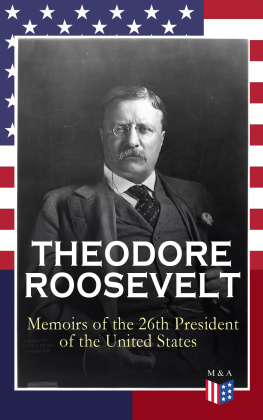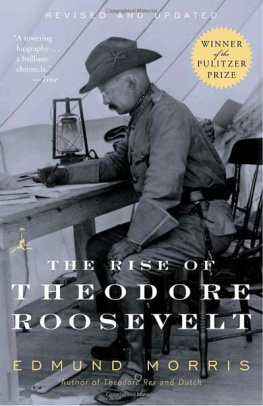Barakaldo Books 2020, all rights reserved. No part of this publication may be reproduced, stored in a retrieval system or transmitted by any means, electrical, mechanical or otherwise without the written permission of the copyright holder.
Publishers Note
Although in most cases we have retained the Authors original spelling and grammar to authentically reproduce the work of the Author and the original intent of such material, some additional notes and clarifications have been added for the modern readers benefit.
We have also made every effort to include all maps and illustrations of the original edition the limitations of formatting do not allow of including larger maps, we will upload as many of these maps as possible.
THEODORE ROOSEVELT
AND THE RISE OF THE MODERN NAVY
Gordon Carpenter OGara
Table of Contents
Contents
Table of Contents
REQUEST FROM THE PUBLISHER
DEDICATION
To Harold and Margaret Sprout
PREFACE
HERE is an attempt to show the rise of the American Navy as it is known today. In this growth Theodore Roosevelt played a major role, for while he neither started the New Navy of steam and steel nor brought it to perfection, he did perform a valuable service by indicating the direction of future growth. His administration saw the opening of the era of the super-battleship. By his unparalleled personal activity he made people Navy-conscious and assured a better informed, if not always sympathetic, audience for future requests to meet the needs of the Navy.
The limits of this study obviously make it impossible to develop in detail the political motives behind the Presidents naval program or the Congressional politics involved in carrying it out. Therefore, I have confined myself almost entirely to the presentation of a simple account of the development of the United States Navy from 1901 to 1909.
I have attempted to get at both the official story of the subject as found in the Annual Reports of the Navy Department, Congressional hearings, official documents, etc., and also the views of outsiders and the unofficial opinions of men in the naval administration. These were to be found particularly in newspaper and magazine articles of the time, memoirs, letters and more general books. These two stories were often at variance, but by experience I found that the truth usually was someplace between the two extreme claims. This was Roosevelts opinion and was nearly always borne out by later events.
I wish to thank the publishers and authors who have permitted quotation from their works, as indicated in footnotes.
I take pleasure in acknowledging my indebtedness to The Rise of American Naval Power , by Harold and Margaret Sprout. Furthermore, Professor and Mrs. Sprout very kindly gave me access to their notes and were of indispensable assistance in advising me and suggesting improvements and changes. I also wish to thank Mr. Datus C. Smith, Jr., and Miss Virginia Heide of Princeton University Press, for exceeding their duties as editors to help me, and Professor Dana Gardner Munro, Director of the School of Public and International Affairs of Princeton University, for helping to make this publication possible. I appreciate the efforts and suggestions of Mr. Malcolm O. Young, Reference Librarian of the Princeton University Library, Miss Nora E. Cordingley of the Roosevelt Memorial Library in New York, and Captain Dudley W. Knox of the Office of Naval Records and Library. And I want to thank Rear-Admiral J. B. Oldendorf, U.S.N., who enabled me to work at the Library of the Naval War College at Newport, R.I., as well as Captain K. C. McIntosh, S.C., U.S.N. (Ret.), Officer-in-charge of the Navy Supply Corps School, who made available to me many of his personal notes and suggestions. To all others who assisted me in any way, many thanks.
G. C. OG.
Princeton, N.J.
March 30, 1942
THEODORE ROOSEVELT AND THE RISE OF THE MODERN NAVY
CHAPTER I THE UNITED STATES A WORLD POWER
THEODORE ROOSEVELTS two terms in the White House were among the busiest in American history. He is justly famous for a range of accomplishments from trust-busting to conservation. Most of these have received adequate attention and been widely publicized. Today more than ever, however, it seems important to consider in greater detail than has been attempted up to this time his part in the development of the modern United States Navy.
Thinking in terms of a projected seven-ocean Navy, it is hard to realize that just a few decades ago America was one of the less important naval powers. Yet that is what America was when Roosevelt assumed the Presidency in 1901. Eight years later this country had one of the worlds most powerful battle fleets. The changes wrought during those two administrations laid the groundwork upon which our Navy is building today. While air power in the future may eliminate sea power as an important weapon of war, the strength which we have so far obtained as a result of our modern naval might dates clearly from the eight years while Roosevelt was President.
The international scene against which Theodore Roosevelt developed American naval and foreign policy in the opening years of the twentieth century was essentially dynamic in comparison with the situation that had prevailed since 1815. The remarkable stability of that earlier era of the Pax Britannica was fast disappearing. This trend had been clearly evident from about 1890. It was a result in part of the rise of centers of power in the Western Hemisphere and the Far East.
The spread of the Industrial Revolution to these countries made them independent of British factories and gave them the power potential necessary to maintain a great fleet. The same was true of Germany. There, however, the need for land armaments and British control of the ocean approaches to German ports made the Kaisers bid for sea power less dangerous for Great Britain. On the other hand, this German threat, coming as it did at the same time as the rise of the independent naval powers in North America and Eastern Asia, was an important factor in destroying British control of the seas. It necessitated the withdrawal of large naval forces from the Pacific, the western Atlantic-Caribbean and the Mediterranean areas to bolster the Home Fleet against the German force in the North Sea.
By 1900 the United States, therefore, found itself supreme in the waters of North America. America even received British encouragement, for the Mother Country saw that the only way to maintain its influence in the western Atlantic or Caribbean was to keep on friendly terms with the American Navy. Similarly in the Far East, the Japanese Fleet had no serious rival. Great Britain recognized this in 1902 by signing the Anglo-Japanese Naval Alliance, by means of which Britain hoped to preserve its power in the Pacific.
This picture as seen from America was most happy, at least for purposes of defensive naval strategy. In the Atlantic the only possible rivals were the Germans and the British, and these were holding each other at bay across the North Sea. The German Fleet could never hope to get past the British Isles and reach North America. England was unable to wage war in Europe if America was hostile, because England had to keep open the Atlantic supply lines. The western Atlantic and Caribbean were thus safe. The eastern Pacific was likewise under the indisputable control of the American Navy because of the tremendous distances of that ocean, because of the advance bases acquired by the United States in 1898 and because Japan and Russia were holding each other in check in Manchuria. Furthermore, the coasts of the United States were absolutely safe from naval blockade due to the overwhelming technical difficulties involved in such an operation. {1}












